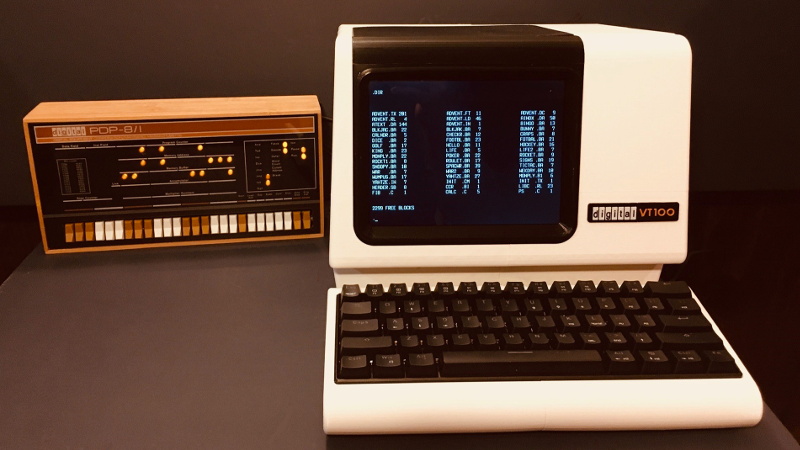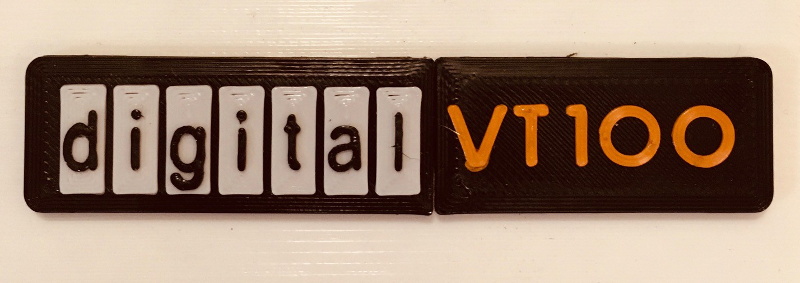When he went shopping for a vintage serial terminal to go along with his reproduction PDP-8/I computer, [Michael Gardi] came down with a bad case of sticker shock. But rather than be discouraged, he reasoned that if his “retro” computer could stand to have modern components at its heart, so could the terminal he used to talk to it. Leaning on his considerable experience in designing 3D printed replica hardware, he’s built an absolutely gorgeous scaled down DEC VT100 terminal that any classic computer aficionado would be happy to have on their desk.
 Now to be clear, [Michael] hasn’t created a true serial terminal. Since the faux PDP-8/I is running on a Raspberry Pi, all he needed to do was come up with something that could connect to its HDMI and USB ports. Put simply, he’s essentially just made a 3D printed enclosure for the Pi’s monitor and keyboard. Oh, but what a gorgeous enclosure it is.
Now to be clear, [Michael] hasn’t created a true serial terminal. Since the faux PDP-8/I is running on a Raspberry Pi, all he needed to do was come up with something that could connect to its HDMI and USB ports. Put simply, he’s essentially just made a 3D printed enclosure for the Pi’s monitor and keyboard. Oh, but what a gorgeous enclosure it is.
Recreating the VT100 in CAD was made more difficult by the fact that [Michael] couldn’t get his hands on the authentic hardware. But of course, that’s never stopped him before. It turns out DEC provided some very detailed dimensions for the terminal in their original documentation, and while comparing them to photographs of the actual terminal did uncover a few key differences, the overall look is spot on. Once the design was done, he reports it took two rolls of filament and more than 200 hours to print out all the parts for the enclosure.
To help sell the authentic look [Michael] tracked down a 4:3 LCD of the appropriate size, and the use of an off-the-shelf portable mechanical keyboard should make text entry a pleasure. For a little fun, he even came up with a themed arcade controller for the VT100 that can be used with RetroPie. The printed logo plate is an especially nice touch, and we’re more than willing to forgive the fact that he had to print it at a larger scale than the rest of the terminal to get all the detail in with his printer’s 0.4 mm nozzle.
On a technical level, this is perhaps the most straightforward replica we’ve ever seen from [Michael]. But even on a relatively simple project like this, his signature attention to detail and craftsmanship is on full display. It’s always a good day when he’s got a new build to show off with, and we’re eager to see what he comes up with next.

















The VT100 set the standard for 80-character terminals, I did a lot of work on those, and they beat the snot out of the older VT-52. But the VT-220 was the crown jewel of its age: amber or green text (the former favored by blue-eyed programmers), and programmable graphic glyphs which did a surprising job of displaying graphics when encoded cleverly. Of course that was already in the VAX/VMS PDP-11 age, the PDP-8s were long gone.
DECmate was a VT-100 with an integrated word processor based on a PDP-8.
Beautiful! And no actual terminals were harmed in the making of this project.
I’m waiting for the VT-220 which, in addition to all the good stuff @joelfinkle notes, was symmetrical in its case. Yes, you could flip it physically upside down and leave it next to the other 15 or so in a row in “the computer room” and watch the brilliant young engineers try to figure out how to turn the text upright with a command rather than simply picking it up.
That’s cool. I have the 1/3 scale PDP-11/70, and just use ‘cool-retro-term’ on one of my displays (ssh into the rpi4 running the show), but this gives it even more ‘retro’ appeal. Neat!!
Nice job, but one should note that the VT100 was introduced a full decade after the PDP-8/I. The VT05 would be more period correct, and is, in my opinion, far cooler looking. Time to fire up the 3D printer…
You are absolutely right on both counts. I posted a log to this project to that effect: https://hackaday.io/project/177596-23-scale-vt100-terminal-reproduction/log/189340-timing. I still went with a VT100 because of it’s iconic status. I too love the “Jetsons” look of the VT05 and would love to see it get some reproduction love.
Sorry, read this on my phone, so I didn’t read the log. Since I programmed the PDP-8/I and 11/20 back in the early 70s, I can say we always had an ASR33 attached as the console, mostly so we wouldn’t need the tape reader peripheral. Paper tape was occasionally needed for boot, even if a disk or DECtape was present. However, we all had Hazeltine 2000 (amber screen, of course) terminals on our desks. The DEC video displays were far too expensive and clunky until the VT52 came out.
Thank you so much for sharing Marc. I love getting first hand accounts like this.
Another historical note: from 1973 to 1976 I worked for Applied Data Research (ADR), developing embedded software for various minicomputers using in-house developed MIMIC assemblers, linkers, and simulators that ran on a PDP-10. Much of the original MIMIC code was written by my then manager, Bob Supnik. I wrote several peripheral emulators and at least two CPU simulators.
A decade or so ago, I received an email from Bob asking if I had any of the old MIMIC listings in a closet. He obviously managed to find them, and proceeded yo hand translate the code from PDP-10 assembly language to C, thus creating the SimH family of applications. The SimH simulator that runs on the replica PDP-8/I and PDP-11/70 are basically the same code we used in 1973.
Nice!